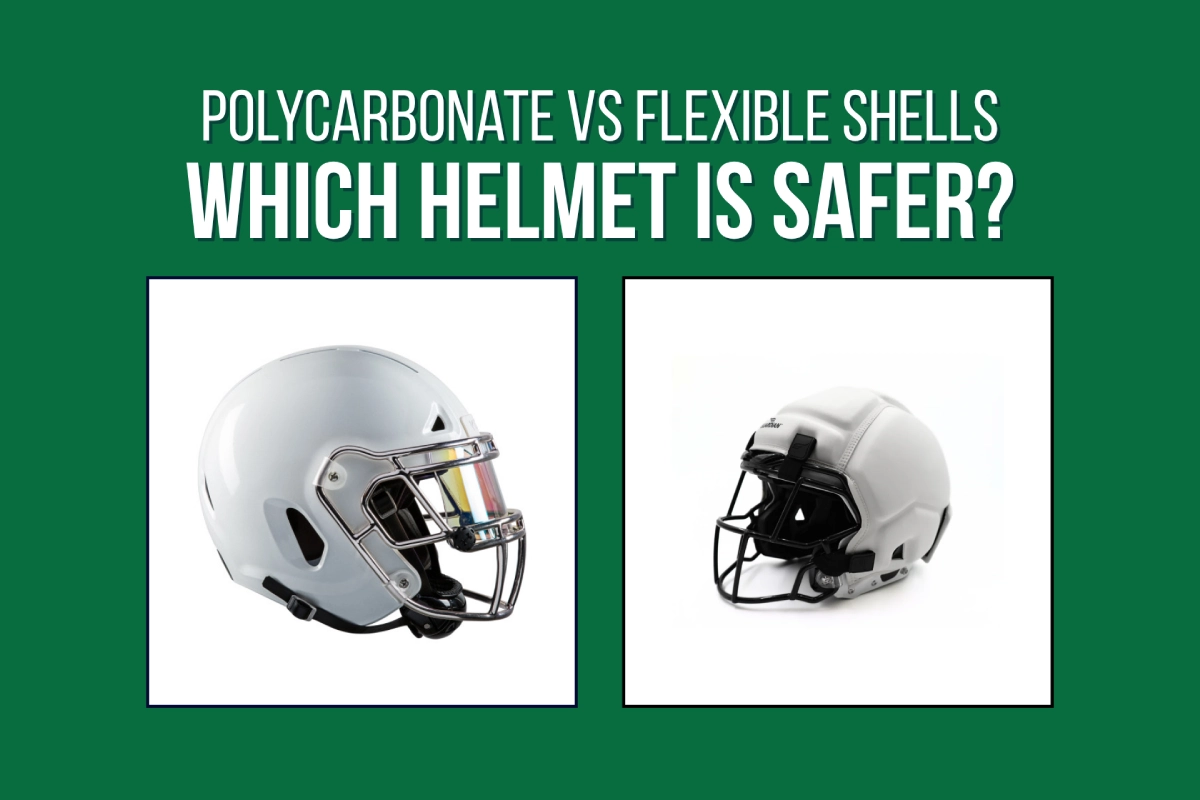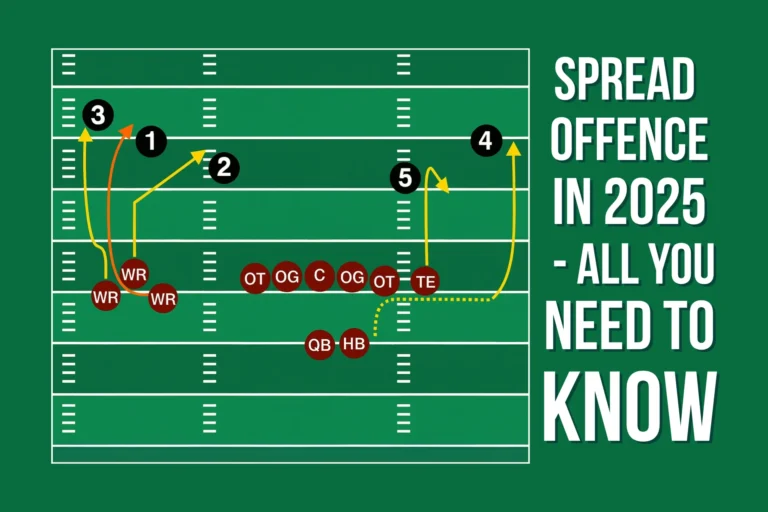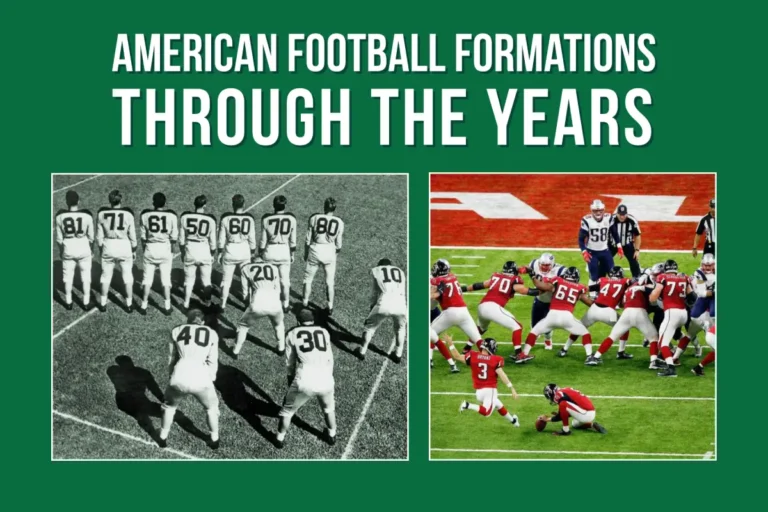Football helmets have came a long way since the days of squishy leather caps. Modern players sprint faster and hit harder than ever, yet they trust a piece of plastic on their head to keep them safe.
We all care about player safety, but a big debate lingers: polycarbonate vs flexible shells – which helmet is safer? It’s a pressing question for NFL stars and pee-wee players alike.
Fans and parents want the safest helmet possible for their heroes and kids. Helmet manufacturers have responded by innovating beyond the old hard-shell designs.
But here’s the catch: not all helmet shells work the same way to protect the brain.
So, does a super-rigid helmet shell or a new flexible shell do a better job at reducing concussions? Let’s have an in-depth look at the differences between traditional polycarbonate helmets and the latest flexible-shell designs in football – and find out which might truly be safer on the field.
The Traditional Polycarbonate Helmet Shell
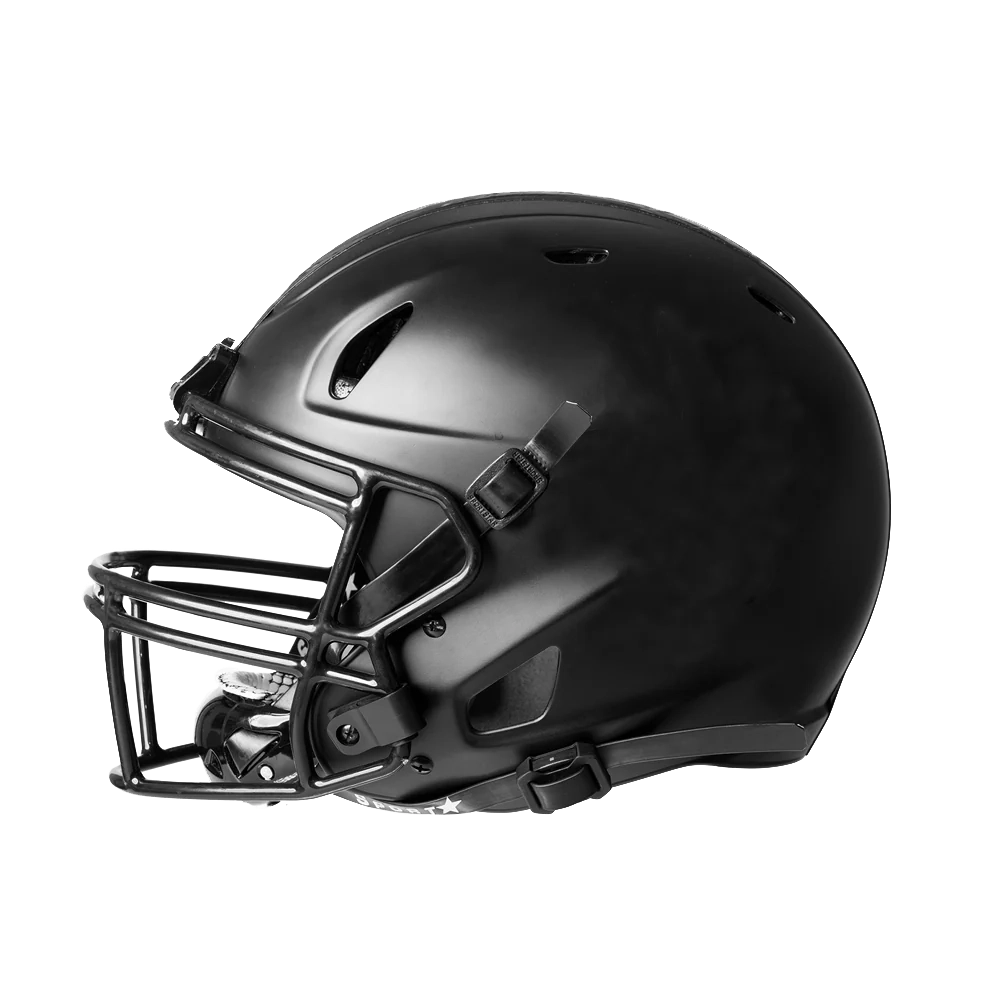
First up: the classic polycarbonate football helmet. Polycarbonate is a type of hard plastic, and it’s been the standard for varsity and pro helmets since the 1980s. If you played high school ball, chances are your helmet had a polycarbonate shell.
Why?
This material is incredibly tough for its weight. A polycarbonate helmet shell is rigid and extremely good at two things: distributing impact and not cracking under stress. When you collide with an opponent, a hard shell spreads out the force of the blow across the surface, instead of concentrating it in one spot. That helps protect your skull from fractures or serious head trauma. In fact, polycarbonate replaced older fiberglass shells decades ago because it was better at handling repeated hits without breaking.
Make no mistake, these helmets are built like a tank (just a lot lighter). A traditional polycarbonate helmet can take thousands of collisions over a season.
Consider this: NFL and college helmets get sent in for reconditioning each year – repainting, new padding, and impact testing – and the same shell often comes back for more seasons. That’s how durable they are. The hard shell holds up, which is crucial when players are crashing into each other every play.
But not so fast – a rigid shell has its downsides.
On the flip side, that very stiffness means the shell itself doesn’t absorb much of the impact; it passes most of the energy inward to the helmet’s padding (and, ultimately, the player’s head). The classic helmet design for the last 40+ years has been a hard outer shell with foam padding inside. It does a great job preventing skull fractures – the hard shell is like armor against direct blows. However, for concussions (caused by the brain jostling inside the skull), just having a hard shell isn’t enough. The inside padding and the fit play a huge role in cushioning the brain.
In fact, helmet makers have recognized this and continuously improved internal padding over the years to manage impact energy better.
Still, engineers wondered if the shell itself could do more to soften the blow. After all, a car’s exterior isn’t rock-solid; it crumples in a crash to absorb energy.
You might be wondering: can a football helmet shell be designed to “crumple” (in a controlled way) too? That idea leads us to the new kid on the block – flexible shell helmets.
Key Traits of Polycarbonate Shell Helmets
-
Hard, Rigid Protection: Polycarbonate shells are very stiff and spread out the force of impacts. They act like armor against fractures, keeping your skull intact by distributing the hit over a wider area.
-
Highly Durable: These shells can withstand season after season of collisions without cracking. They’re tough enough to handle the hardest hits on the field, which is why they’ve been the standard at high levels for decades.
-
Relies on Internal Padding: Because the shell itself doesn’t flex much, the helmet’s interior padding and liners are critical. The foam compresses to absorb shock and protect your brain. The shell’s job is mainly to prevent catastrophic injury (and it’s very good at that).
-
Improved but Still Rigid: Recent helmet models have added minor flex features – for example, the Riddell SpeedFlex introduced a flexible panel in the front of the polycarbonate shell to cushion frontal impacts. Even so, the overall shell is still hard plastic, only bending slightly in certain spots. These are incremental tweaks to a fundamentally stiff design.
Polycarbonate helmets aren’t going away anytime soon. They’ve proven effective and reliable at protecting players from severe head injuries. But the limitation is clear: a rigid helmet can only do so much when it comes to reducing the g-forces that cause concussions. Helmet innovators knew there might be another way, and that set the stage for a radical new approach – the flexible shell helmet.
Flexible Shell Helmets: A New Approach to Impact Absorption
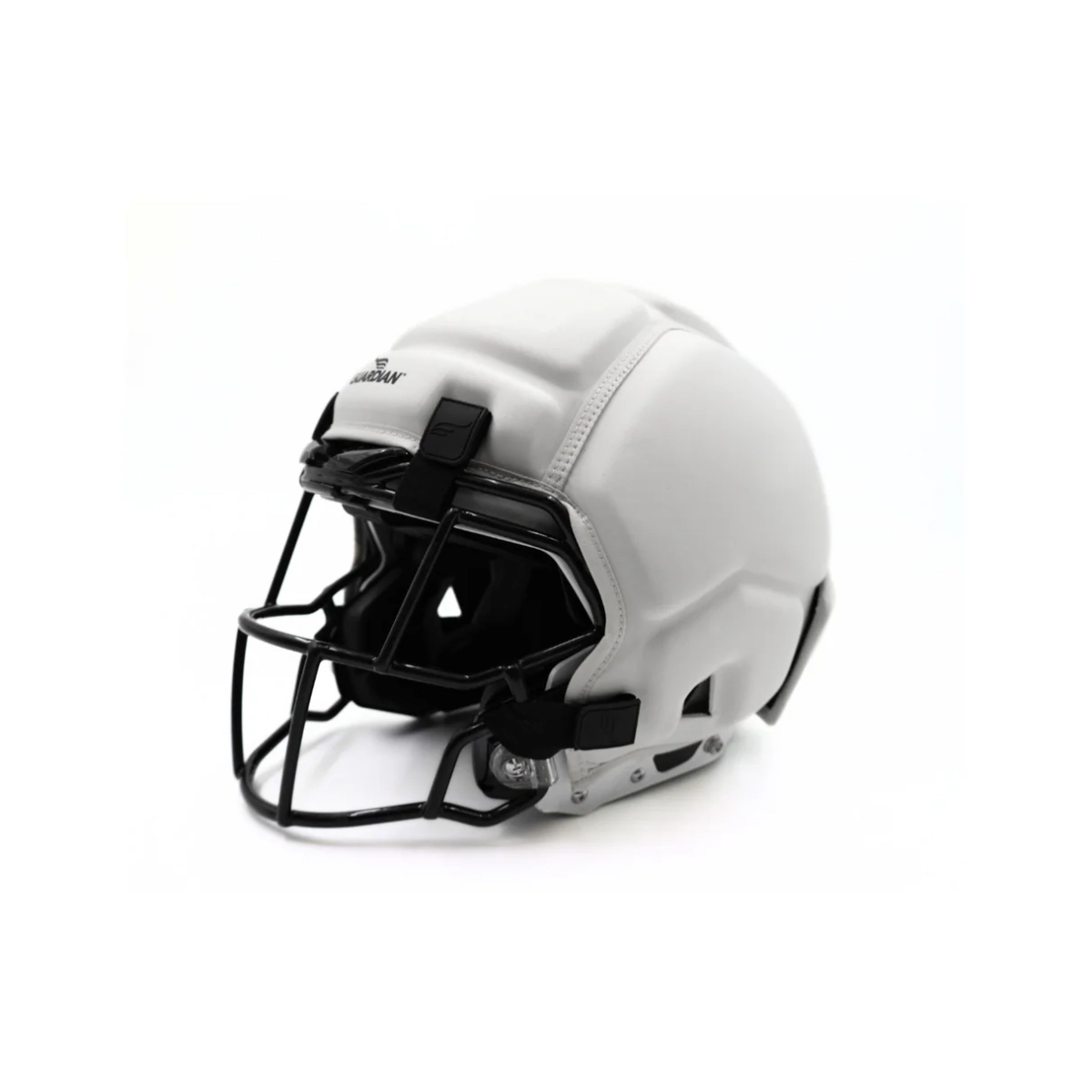
Now, enter the flexible shell helmet – a truly different philosophy in head protection. The poster child of this movement is the Vicis Zero1, a helmet that debuted in 2016 with an outer shell that actually deforms on impact. This was a big shift from the old hard hat mentality.
Instead of a rock-hard polycarbonate exterior, the Vicis shell is made of a bendable polymer. When you hit something, the shell gives a little, kind of like a car bumper crumpling in a minor fender-bender.
Here’s the deal: a flexible shell can absorb impact energy by temporarily deforming, which means less of that energy gets through to your head. Think of it like an extra layer of cushioning.
In lab tests, this concept showed huge promise. The flexible outer layer works together with innovative inner padding to cushion both linear impact (straight-on hits) and rotational force (those twisting hits that can cause concussions) more effectively than a traditional helmet.
The Vicis Zero1 and its successors (like the Vicis Zero2) have a multilayer design. The shell itself is the first line of defense: it flexes upon impact to soak up force. Beneath that, Vicis helmets have a layer of squishy shock absorbers (hundreds of little column-like structures) that compress and move to further dissipate energy.
It’s a high-tech take on a simple idea – allow parts of the helmet to sacrifice themselves (deform or crush) to save your brain, much like a crumple zone on a car. Believe it or not, this approach borrows from auto safety engineering, and it makes a lot of sense in physics terms.
Here’s a quick example to illustrate the difference:
Imagine dropping an egg. A hard plastic container might keep the eggshell from cracking, but the yolk inside will still splatter from the jolt. Put the egg in a softer, padded container, and the padding (or a flexible shell) slows the impact so the yolk stays intact. In football terms, your brain is the egg yolk. A flexible shell helmet aims to protect the brain by slowing down the hit, not just shielding the skull.
But does it work on the field?
Early signs say yes. Flexible shell helmets quickly rose to the top of safety rankings in independent testing. In fact, the first Vicis helmet earned the highest score in the NFL/NFLPA helmet laboratory tests when it came out, outperforming many established helmets.
NFL players took notice: within a couple years, dozens of players (including star quarterbacks and linemen) switched to the Vicis because of its safety reputation. The entire Seattle Seahawks roster even adopted it at one point. That’s a big vote of confidence in the new tech.
Another benefit is how the flexible shell handles different kinds of hits. Traditional helmets mostly just bounce off each other on contact. A flexible helmet, however, can dampen the collision.
Here’s the kicker: even rotational impacts (like glancing blows that make the head twist) are mitigated by certain flex helmet designs. For example, Schutt’s helmets added small elastic “Tektonic plates” on their shells to reduce rotational force. Vicis’s whole-shell approach takes it further – the entire surface gives, so it doesn’t catch friction or stick on another helmet upon impact. (Engineers call that avoiding “mechanical interlock,” meaning two soft surfaces grabbing each other instead of sliding; Vicis uses a slick, low-friction shell material to prevent that problem.)
In short, flexible shells tend to glance off or deform and rebound, rather than hit like two solid rocks.
Standout Features of Flexible Shell Helmets
-
Deformable Outer Shell: Unlike rigid polycarbonate, the flexible shell bends and absorbs energy on impact. It’s designed to act like a shock absorber, so less force is transferred to the head. Players describe it as the hit feeling “softer” because the helmet gives a bit on contact.
-
Multi-Layer Cushioning: Inside these helmets, you’ll find advanced padding systems (columns, pods, or other tech) that go beyond standard foam. These layers can compress, collapse, or even shift to reduce both straight-line impact forces and the tricky rotational forces. It’s a holistic approach to dissipating energy.
-
Localized Flex: A key advantage – the shell only bends where it’s hit, not as one big dent. For example, if you get popped on the side, that area of the shell flexes inward to absorb the blow, while the other side of the helmet stays put. This local deformation means the helmet isn’t just sliding your whole head around; instead, it’s cushioning the specific impact point. According to Vicis’s engineers, that precise flex is a big reason for the improved protection over designs that only flex in one spot.
-
Tested and Top-Rated: These designs have dominated recent safety tests. The Vicis Zero2, for instance, has ranked among the very safest helmets in the NFL’s annual helmet testing for multiple seasons. In 2020 it was rated the #1 helmet by the NFL/NFLPA, and in 2023–2025 variants of Vicis helmets continued to perform at the top for various positions. In other words, the lab data backs up the concept – flexible shell helmets can reduce impact forces significantly compared to many traditional shells.
-
Innovative Fit Systems: Many of these helmets forego old-school air bladders. For example, Vicis uses interchangeable foam pods for a custom fit, rather than pumping air. This can make the helmet easier to fit and potentially more stable, since there’s no risk of an air bladder leaking. Riddell’s new helmets (like the SpeedFlex Precision and Axiom) have also moved toward 3D scans and custom pads. A secure fit is crucial for safety, and both shell types can achieve it in different ways (air vs. pads), but flexible shell helmets emphasize easy, consistent fit without pumps.
Flexible shells sound amazing, and they are a huge leap forward in helmet tech. But to answer our main question – which helmet is safer – we need to directly compare how polycarbonate and flexible shell helmets perform when it counts: on impact. So let’s put them head-to-head.
Safety Showdown: Which Helmet Shell Offers Better Protection?
So, which helmet is safer, the old-school hard shell or the new flex shell?
The answer might surprise you: it’s not a simple black-and-white verdict, but the evidence tilts in favor of the flexible shell when it comes to reducing concussion risk.
Lab Testing and Rankings
Each year, the NFL and NFL Players Association conduct extensive lab tests on all approved helmet models. These tests measure how much impact force a helmet lets through to a dummy head – both from direct hits and angled hits – to produce a safety ranking. Helmets that perform best get a “Top-Performing” green rating, while lower performers are yellow or red (prohibited). Guess what? In recent years, helmets with advanced impact technology (often including flexible elements) have dominated the top spots.
For instance, a few seasons ago the Vicis Zero1 and Zero2 were consistently top-ranked. More recently, Riddell introduced its Axiom helmet with new flex features and 3D padding, which also shot up near the top of the list.
The takeaway is that the newest helmets – many of which use some form of flex or specialized cushioning – are testing better than the older, purely rigid designs.
In 2024, the NFL announced that several new helmets achieved record-high safety scores, outperforming all previous helmets tested. These included both a fully flexible shell model and others that blend hard shells with improved padding. In fact, the pace of innovation is so fast that helmets which were top-rated just a few years ago (all rigid shells) have already been downgraded or even phased out. That speaks volumes about how much safer the new technology appears to be.
One telling statistic: according to the NFL’s Engineering team, players in the top-performing helmet models had measurably lower rates of concussions than players in older helmet models. Last season saw the fewest concussions on record in the NFL, and improved helmets were credited as one of the factors.
Now, no helmet can prevent all concussions – let’s make that clear.
But even a small reduction in impact forces can make a difference. A study cited by a Vicis co-founder noted that a 5% reduction in force could correspond to a 40% reduction in concussion risk. That’s huge if accurate. While those numbers are still being validated, it underscores why engineers are chasing any and all improvements in helmet tech.
In simpler terms: today’s elite helmets (almost all 5-star rated in Virginia Tech’s safety ratings) will protect you better than helmets from 10-15 years ago. And among those elite helmets, the ones incorporating flexible shell designs have often edged out the others in lab metrics.
For example, as of 2025 the Vicis Zero2 Trench (a variant with an extra padding for linemen) is the top-rated helmet for linemen in NFL tests, and Vicis flexible models have been at or near #1 for multiple positions.
Meanwhile, Riddell’s best (like the Axiom or SpeedFlex Diamond) also score extremely well – demonstrating that a well-designed polycarbonate helmet with some give can be excellent too. The gap at the very top is narrower now, but flexible tech is leading by a nose.
Field Experience and Player Feedback
Lab tests are great, but what about on the field under real hitting? Many players who have worn both types have reported differences. Some NFL players who switched to flexible shell helmets have said that hard hits “felt a little less jarring.” The flexible shell seems to cushion the blow – that’s exactly its job. If you watch slow-motion replays, you can sometimes see a flexible helmet compress slightly on impact, almost like a sponge absorbing a punch. A traditional helmet, by contrast, stays stiff and pops off the other object more (sending more force into the head).
Another thing to note is that the NFL introduced Guardian Caps in practices starting in 2022. Those are the odd padded covers you see over helmets during training camp. They effectively turn a regular polycarbonate helmet into a temporarily “soft-shell” helmet by adding an extra flexible layer on the outside.
The NFL did this after research showed that adding a soft layer can reduce impact forces. According to the league, when one player wears a Guardian Cap, it cuts impact force by about 10%. If both players in a collision wear them, impact force can drop by around 20%. That’s significant, and indeed preseason concussion rates dropped notably with Caps on.
Why is this relevant?
It’s proof of concept that a more deformable outer surface (even just a padded wrap on a hard helmet) lowers force transmission. A flexible-shell helmet is essentially built on that same idea, but engineered from the ground up for games. (For clarity: Guardian Caps are not used in games, but the fact the NFL mandates them in practice for high-impact positions shows how valuable extra flexibility can be in reducing injuries.)
All that said, helmet safety isn’t just about the shell material. The overall design, padding, fit, and even weight distribution matter. The best polycarbonate helmets today also have cutting-edge padding and sometimes custom fitting, making them far superior to older models. A poorly fitting flexible helmet might not protect as well as a perfectly fitted traditional helmet, simply because if a helmet slides around on impact, it’s less effective. That’s why proper fit is emphasized for both types – buckle that chinstrap snugly!
So Which Is Safer?
Bottom line: A top-tier flexible shell helmet is generally safer in terms of impact reduction than a traditional all-polycarbonate helmet, according to current data. It’s engineered to absorb more force before it ever reaches your skull. That means a lower likelihood of your brain getting rattled on a given hit. The flexible shell approach has proven itself in both labs and on the field at the highest levels.
However, this doesn’t make polycarbonate helmets “unsafe” by any stretch. The best rigid-shell helmets today also perform exceptionally well and carry 5-star safety ratings. They too have benefited from improvements like better foam, better facemask connectors, and slight flex features. For example, the Riddell SpeedFlex (a hard shell helmet with a flex panel) has been one of the most popular and well-rated helmets for years. It’s not as if wearing a polycarbonate helmet is a risky choice – far from it.
All modern helmets have to pass strict safety standards (set by NOCSAE), and only approved helmets can be used in games. Both types will protect you from severe head injury in most scenarios. The difference lies in that extra margin of concussion risk reduction that the newer flexible designs aim to provide.
In summary, if we’re directly comparing polycarbonate vs. flexible shell on the question of safety: the edge goes to flexible shells for their superior energy absorption and recent track record in reducing impact forces. As one NFL health official put it, helmet technology is taking a “huge step forward” lately – and flexible shells are a big part of that step. But remember, the safest helmet is one that fits you well and that you’ll wear properly every time. The technology has come a long way, yet football by nature will never be 100% concussion-proof. What we can do is keep pushing for improvements, and that’s exactly what’s happening with these new helmet innovations.
Beyond Safety: Weight, Comfort, and Practical Differences
By now, it’s clear that flexible shell helmets have a technical safety advantage. But choosing a helmet isn’t only about lab results. Comfort, weight, durability, and cost are also important for players and teams. So, how do polycarbonate and flexible shell helmets stack up on these everyday factors?
Weight
A lighter helmet can reduce neck fatigue, especially for youth players. Traditional polycarbonate shells are already quite lightweight and strong – that’s why polycarbonate was favored over older heavier materials. Flexible shell helmets, with all their extra layers, started out a bit heavier.
The first Vicis Zero1 was slightly heavier than a Riddell SpeedFlex (roughly in the 4.5-pound range, vs around 4.0 pounds for the SpeedFlex). The designers have worked on this, and the newer Vicis Zero2 is about 15% lighter than the original model, bringing it closer in line with other helmets. According to Vicis, their helmets are now roughly the same weight as a SpeedFlex – impressive given the added tech inside. Schutt and Xenith have some of the lightest helmets on the market (using standard shells but advanced materials); some varsity helmets are as low as 3.5 lbs.
So at the top level, weight differences aren’t huge. A few ounces won’t make or break a helmet choice for most, but it’s good to know flexible helmets have slimmed down from their early iterations.
Comfort & Fit
This is very personal. Some players love air liners in helmets, which are common in many polycarbonate models – you pump them up to get a snug custom fit. Others dislike that maintenance and prefer a helmet that you can just put on without fuss. Flexible shell helmets like Vicis use modular padding for fit, which equipment managers can swap in/out to fine-tune.
Riddell’s newest Axiom helmet (polycarbonate shell, but lots of innovation) uses 3D scanning to create padding unique to the player’s head. In short, both helmet types can offer an excellent fit.
Here’s the important part: a helmet should feel secure and comfortable all game long.
Flexible shell helmets have an advantage of no pressure-point from stiff spots – the shell gives a bit, so it can feel less tight in a weird way, even while fitting properly. Meanwhile, traditional shells are very snug when fitted right, and some players feel that solid “locked in” sensation and like it.
Neither is wrong; it comes down to preference and getting the right size and adjustments.
Ventilation might be worth noting too. Hard shells and flexible shells alike have air vents (those cutouts you see on the helmet) for cooling. The presence of flexible panels doesn’t really change ventilation much. If anything, some flex helmets (like Vicis) have slightly fewer large vents because of their layered construction, but they compensate with interior channels to circulate air. No one wants a boiling hot helmet, so manufacturers ensure airflow in both designs.
Durability & Maintenance
Coaches and equipment staff care about how well helmets hold up. Polycarbonate helmets have a proven lifespan – many can be used for up to 10 years (with annual reconditioning) if they don’t sustain a crack. They’re extremely tough against normal impacts.
Flexible shell helmets have to meet the same certifications for impact and crack resistance, so they’re durable too, but there were questions initially: Will a softer shell scuff or tear? So far, they’ve held up well in practice. The outer layer on a Vicis will scratch and gouge like any helmet, but it’s built to bounce back shape-wise.
One fun fact: painting a flexible helmet was a challenge. Vicis had to develop a special paint process so that the paint doesn’t chip off when the shell flexes – something rigid helmets don’t have to worry about. They solved it, so teams can have their glossy colors and logos on these helmets just fine.
Reconditioning flexible helmets might be slightly different (the reconditioners had to learn how to work with the new shell material), but it’s being done routinely now. Both types need to be inspected for any cracks or damage. If a polycarbonate shell cracks, it’s game over for that shell (rare but can happen with a severe impact). If a flexible shell somehow tore or got punctured deeply, that would also sideline it. In normal use, though, teams are finding these helmets can last multiple seasons no problem.
Cost
Here’s a practical factor that can’t be ignored. Flexible shell helmets, being new and high-tech, come at a premium price. When first released, the Vicis Zero1 cost around $1,500 – roughly 4-5 times the price of a standard helmet.
That price has come down: a Vicis Zero2 adult helmet now retails for about $700 (still quite steep). A popular polycarbonate helmet like the Riddell SpeedFlex runs around $400-$500 for adult sizes, and some basic models can be $300 or less. For youth and high school programs on a budget, outfitting an entire team in $700 helmets might not be feasible.
In other words, cost and accessibility are reasons polycarbonate shells remain widespread. The cutting-edge tech usually starts at the pro level and filters down as it becomes more affordable. The good news is that as more manufacturers include flexible designs and competition rises, prices should slowly moderate. Vicis, for instance, introduced youth versions of their helmets at lower prices, and other companies are now integrating similar energy-absorbing features into helmets at various price points.
Real-World Adoption
At the NFL level, players have a menu of approved helmets to choose from each year, and they often try on several to see what feels best. About half the league now wears the top-rated (dark green) helmets, and a growing chunk of those are the newer models with flex features.
Still, many players stick with what they know if it’s working for them – for example, some veterans love their older Riddell Speed helmets (an older polycarbonate model) and haven’t switched. Comfort and habit play a role. The NFL won’t allow truly unsafe helmets (they’ve banned a bunch of older models), so among the approved ones it becomes a matter of personal comfort and marginal gains. In college and high school, adoption of flexible shell helmets is increasing year by year, especially as more data comes out supporting their safety benefits. But plenty of athletes continue to wear traditional-shell helmets that also have top safety ratings.
At the end of the day, whether your helmet shell is hard or flexible, you want the whole package – a well-fitting, well-padded, up-to-date helmet. The shell is one piece of the puzzle, albeit an important one. And right now, the flexible shell is the most exciting piece in helmet design.
Final Thoughts: Choosing Safety in 2025 and Beyond
It’s 2025, and football helmet technology has never been more advanced. Polycarbonate vs. flexible shell is a comparison of great vs. even greater in terms of safety. A quality polycarbonate helmet with modern padding is very safe by historical standards. But the flexible shell designs are pushing the envelope, aiming to make the game that much safer against brain injury.
The data and player experience so far suggest that the flex approach is a real improvement in helmet safety – not a magic cure for concussions, but a significant step in the right direction.
For players, parents, and coaches reading this: you don’t necessarily need the latest $700 helmet for good protection, but you should definitely ensure you have a recent model that scores high on independent safety tests. All the big manufacturers now have highly rated options. If you have the means to get a helmet with a flexible shell or advanced impact system, it’s worth considering for the added peace of mind.
The question of “which helmet is safer” ultimately comes down to which specific models you’re comparing.
And the truth is, the safest helmets today incorporate a mix of both worlds – strong shells with strategically flexible features and premium padding inside.
The competition between manufacturers has led to rapid innovation. That’s great news for players. Riddell, Schutt, Vicis, Xenith, and others are all finding new ways to make helmets absorb more impact.
It might be a fully flexible shell, or a new foam that behaves differently, or a combination of both. In a way, “polycarbonate vs flexible” is starting to blur as hybrid designs emerge. The goal is the same: protect the athlete’s brain. And every year, we’re seeing improvements towards that goal.
So, which helmet is safer?
The one that’s engineered with the latest safety tech and fits you perfectly. For now, flexible shell helmets have the edge in absorbing impact. Don’t be surprised if in the near future almost every helmet has some sort of flex zones or deformable components – that seems to be where things are headed.
Football will always be a collision sport, but thanks to these advancements in helmet design, players can feel a bit more secure when they step onto the gridiron.
Stay safe out there, and keep your head up – both figuratively and literally!
FAQ
Q: Do flexible shell helmets prevent concussions completely?
A: No helmet can guarantee to prevent concussions. Flexible shell helmets do reduce the force of impacts compared to traditional designs, which can lower the risk, but they don’t make players invincible. You can still get a concussion in any helmet if the hit is severe enough or at a bad angle. The flexible shells are about improving odds and reducing severity, not eliminating the risk entirely. Good tackling technique and rules against dangerous hits are also key parts of concussion prevention – not just the helmet.
Q: Why are polycarbonate shells still used if flexible shells are safer?
A: There are a few reasons. Firstly, polycarbonate helmets have a long track record of protection – they’re already very safe and meet all standards. Many current polycarbonate-based helmets are 5-star rated and trusted by players. Secondly, cost and availability play a role. Flexible shell helmets are expensive and were in limited supply initially. Not every program can afford to buy all players $700 helmets. Polycarbonate shells are more affordable and easier to mass-produce, so they remain the go-to for most teams. Lastly, player preference matters. Some athletes are simply more comfortable in a traditional helmet they’ve used for years. As flexible designs become more common and cost comes down, you’ll likely see even wider adoption, but polycarbonate isn’t going away – it’s being refined and often integrated with new tech (like flex panels and improved padding) to keep pace.
Q: Are flexible shell helmets allowed at all levels of football?
A: Yes. Flexible shell helmets (such as those by Vicis and others) are certified by NOCSAE and approved for gameplay in the NFL, NCAA, high school, and youth leagues – just the same as any other helmet. They undergo the same testing to ensure they meet safety standards for impact and structural integrity. The NFL and other leagues don’t mandate a specific type of helmet; they provide a list of approved models. As long as a helmet (flexible or not) is on that list and properly certified, players can wear it. For example, a few years back when the Vicis debuted, NFL players had the green light to use it, and many did. Now there are even youth versions available for kids that use similar flexible shell technology.
Q: How long does a football helmet last, and do flexible shells hold up over time?
A: Football helmets, in general, are typically used up to 10 years, but they must be inspected and reconditioned every year to stay in top shape. During reconditioning, technicians will repair or replace parts, deep clean the helmet, and perform tests. Polycarbonate shells, if they don’t crack, can go many seasons of reconditioning. Flexible shell helmets are proving to be similarly durable. Their outer shells are tough and bounce back from routine impacts without permanent deformation. Teams have been reconditioning Vicis helmets yearly just like others.
So yes, they hold up well.
Of course, if any helmet takes an extreme hit and the shell is compromised (cracked, etc.), it should be taken out of service immediately. But under normal use, a flexible shell helmet should last as long as a traditional one. Always check the manufacturer’s guidelines – some suggest a slightly shorter lifespan for newer materials, but so far there’s no indication that you have to replace a flex shell helmet more frequently than a standard helmet.
Q: I’ve seen NFL players wearing those padded “Guardian Caps” in practice. Is that similar to a flexible shell helmet?
A: The idea is similar in that the Guardian Cap is a soft, flexible layer that goes on the outside of a hard helmet to absorb impact. In practice, when players wear those caps, the foam padding of the cap compresses on hits – which is like giving a standard helmet some of the properties of a flexible shell. The NFL reports that Guardian Caps can reduce impact forces by 10-20%, which is why they mandate them during contact drills for certain positions.
However, a Guardian Cap is just an add-on for practices (they’re not permitted in games), whereas a flexible shell helmet is a complete, integrated design for game use. The helmet’s shell itself is flexible. Think of it this way: a Guardian Cap is a bit like putting a foam mattress topper on a firm bed – it softens the feel a bit. A flexible helmet is like a whole new mattress designed to be softer and supportive in the right ways. Both aim to reduce the force of collisions, but only the actual flexible shell helmets are used in games. The recent use of Guardian Caps is further real-world proof that adding flexible, impact-absorbing material around the head can improve safety.
Q: Are there other helmet materials (like carbon fiber) that are better?
A: Carbon fiber and similar materials have been used in some helmet designs primarily to reduce weight, not necessarily to increase flexibility. A few manufacturers offer helmets with outer shells made of composite materials (carbon fiber, Kevlar blends, etc.). These shells can be lighter than polycarbonate, which is a plus for reducing neck strain. However, they tend to be very rigid – even more rigid than polycarbonate – so they don’t flex on impact.
That means they rely completely on internal padding for shock absorption. They haven’t shown a clear safety advantage in terms of concussion reduction; their benefit is mostly in weight savings. In fact, none of the top-rated helmets in NFL or Virginia Tech studies use carbon fiber shells – most are polycarbonate or similar plastic, with the advances coming in flexibility and interior tech. So while carbon fiber makes for a strong and light helmet, it’s not a magic bullet for safety. The trend in safety is toward managed flexibility (regardless of the shell material) and better energy absorption, rather than just making shells stronger or lighter.
In the end, whether it’s polycarbonate, flexible polymers, or something like carbon fiber, what matters is how the helmet as a whole system protects your head. Every year, engineers are experimenting with new materials (there’s even talk of things like graphene in the future).
The best helmet is one that balances all factors – strength, weight, flexibility, and comfort – to keep you as safe as possible. And as the science evolves, we’ll continue to see improvements that make the game safer for everyone on the field. Stay informed, and always choose a helmet that meets the highest safety standards you can find. Your brain will thank you!

